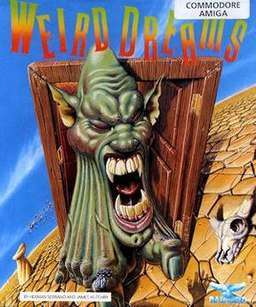Weird Dreams
Weird Dreams is a cinematic platformer game by Rainbird Software which was published for the Amiga, Atari ST, Commodore 64 and MS-DOS. A modified version of it served as the visual component to a phone-in quiz on ITV's Motormouth.[2] The game was planned for release on Amstrad CPC and ZX Spectrum, but both versions were cancelled.[1]
| Weird Dreams | |
|---|---|
 Amiga Cover Art | |
| Developer(s) | Rainbird Software |
| Publisher(s) | Rainbird Software |
| Designer(s) | Herman Serrano James Hutchby Tony King |
| Composer(s) | Barry Leitch (DOS, C64) David Whittaker (Amiga, ST) |
| Platform(s) | Amiga, Atari ST, Commodore 64, MS-DOS |
| Release | Atari ST (April 1989)[1] Amiga (May 1989)[1] MS-DOS (Fall 1989)[1] C64 (1990) |
| Genre(s) | Platform game |
| Mode(s) | Single-player |
Plot
The background story is told by a 64-page novella with 19 chapters written by Rupert Goodwins, featuring the back-story of the game (plus serving as a copy protection). Steve is in love with his attractive coworker Emily. Unbeknownst to Steve, Emily is possessed by a daemon named Zelloripus who was banished to Earth, stripped of most of her powers, and trapped into a human female due to unspecified crimes done to other daemons.
Emily sees a chance to let someone else suffer and stifle her boredom. She tricks Steve to take three pills she has mixed to "cure his flu". While the pills do cure him, they also grant Zelloripus access to his body and mind. His dreams become both more lucid and strange, each one getting more intense and painful. Steve's psychiatrist does not understand what causes the dreams, and neither does Steve. He refers him to a neurosurgeon. After his health dramatically declines, Steve undertakes brain surgery in an attempt to stop the dreams. Under an anaesthetic, he slips into one more dream, possibly his last.
Gameplay
The game starts where Rupert Goodwins' novella ends, with Steve lying on the operating table and slipping into the dream world. Steve is controlled by the player through numerous surreal worlds. He can collect certain weapons and items on these levels, but with a few exceptions, cannot carry them to another level. Steve has no health meter, but there is a heart rate monitor, which goes from 75bpm (normal) to 100bpm (in frightening situations) to 170bpm (shortly before death). He immediately dies if he comes into contact with an enemy or an obstacle. He can also die if he remains too long in certain areas such as the Country Garden, where a lawnmower will come and decimate him. When Steve dies, the game returns to the scene in the operating room where the surgeons attempt to save him. There are no save points in the game, and instead of score points the player's progress is stated as a percentage and a time counter.
There are 15 different enemies/challenges, 7 different death animations and 5 different musical scores by C64/Amiga musician David Whittaker on the Amiga. Barry Leitch did the music for the Commodore 64 and PC version.
Development
The general plot was conceived by the developers, and Rupert Goodwins was asked to write the novella included with the game.[2]
The scenarios in the game are not based on Serrano's own nightmares, but are inspired by the paintings of Salvador Dalí, Terry Gilliam's cartoon animations for Monty Python, and on odd observations. After a visit to the dentist, Serrano developed a phobia of teeth, which is noticeable in the design of the monsters, many of them having mouths with large teeth.
The game took over a year to produce.[3]
Reception
Critical reception
| Reception | ||||||||||||||||
|---|---|---|---|---|---|---|---|---|---|---|---|---|---|---|---|---|
| ||||||||||||||||
Weird Dreams received mixed reviews. While most critics praised its visual style, there were some criticisms depending on the game platform. Frustrating difficulty, long loading times, and a disappointing soundtrack were common criticisms, albeit not unanimous.
Promotion
The Computer and Video Games did a competition called "Ooooh What a Nightmare Compo", which required participants to send a picture of their worst nightmares. The judging was done by a professional artist and the winners received blow-up fish bathtoys and Weird Dreams/Motormouth T-Shirts as prizes.[1]
External links
References
- Eugene Lacey (November 1993). "Game Reviews". Computer and Video Games. No. 90. EMAP. pp. 18–22.
- The Bird Sanctuary
- Penn, Gary (June 1989). "Weird Dreams(Review)". The One for 16-bit Games. No. 9. p. 80. Retrieved 2009-07-04.
- Weird Dreams review from Computer + Video Games 101 (Apr 1990)
- Weird Dreams review from The One for 16-bit Games 9 (Jun 1989)
- Weird Dreams review from ST Amiga Format 13 (Jul 1989)
- Weird Dreams review from Amiga Action 4 (Jan 1990)
- Weird Dreams review from The Games Machine 20 (Jul 1989)
- Weird Dreams review from Zzap 60 (Apr 1990)